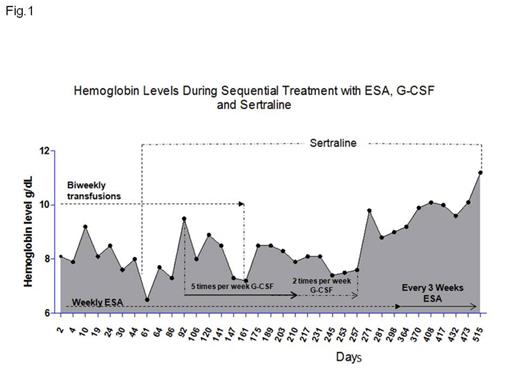Abstract
LR-MDS is a heterogeneous group of clonal marrow disorder associated with ineffective hematopoeisis and complex genomic etiology. For patients (pt) with refractory cytopenia phenotype (RC-P), transfusion and growth factor support, such as Erythropoietin Stimulating Agents (ESAs) and Granulocyte Colony Stimulating Factor (G-CSF), are treatment options. Response rates for ESA is about 30%, (and response potentiation can be achieved in about 35% of pt receiving concurrent G-CSF.However, ESA unresponsiveness is a common phenomenon and is associated with transfusion dependence, normal/high EPO levels, and high IPSS score. Therefore, novel therapies are greatly needed. Biologically, LR-MDS is linked to deregulation of apoptosis and cytokine signaling pathways. Selective Serotonin Reuptake Inhibitors (SSRIs) can induce normalization of deranged cytokines such as IL6 and TNF-α in clinical depression. In animal model of arthritis, sertraline abrogates manifestation of autoimmune arthritis by reducing TNF α. Our group recently showed that significant improvement in overall survival (OS) can be achieved in low-risk MDS patients treated with SSRIs, such as sertraline, which is independent of concurrent MDS directed therapy. (Li, et al. ASH 2012 abstract # 3818) Here, we report a case of sequential reversal of transfusion and growth factor dependence phenotype in a pt with refractory anemia multi-lineage dysplasia LR- MDS.
A 72-year male with transfusion dependent refractory anemia (8 units RBC in 8 weeks) was evaluated in clinic. His bone marrow showed erythroid and megakaryocytic dysplasia consistent with RCMD by WHO 2008 classification. Cytogenetic study revealed 45;X-Y[4];46 XY[16]. R-IPSS=1.5 (Cytogenetic=0; blast [0%] =0; Hb=7g/dL=1.5; Platelets [135000] =0; ANC [1500] =0). EPO and ferritin levels were 449 IU/L and 1600 NG/ML, respectively. R-H-EPO was administered at 40000 IU subcutaneously (SQ) per week. In view of severe depression, pt initiated sertraline at 100 mg orally on day (D) 61 of treatment. Response after 12 weeks of ESA, sequential addition of G-CSF and sertraline, were assessed according to internal working group (IWG) 2006 criteria.
After 3 months of standard weekly SQ ESA (D1-D92) (Fig.1), and given ESA refractoriness, G-CSF at 480 mcg SQ 5-times weekly was added (ESA + G-CSF schedule) (D92-D189).Transfusion independence was observed by D 161 of combined ESA+G-CSF(Fig.1). Progressive hemoglobin stabilization resulted in G-CSF dose reduction to twice a week from D189 –D 257 (Fig. 1). Sequential resolution of ESA dependence was observed from D257- D515. Over the treatment period, the absolute increase in Hb level was 4.2 g/dL from baseline. Restoration of ESA erythroid response was observed by D93-210 after G-CSF and sertraline addition. (Table. 1) Sustained and improved Hb levels were achieved after 200 days of G-CSF discontinuation and ESA dose de-escalation while on sertraline treatment.
Reversal of transfusion dependence represents a critical step in treatment algorithm of LR-MDS pt presenting with refractory anemia. In this context, ferritin normalization has previously been recognized as independent prognostic factor for outcome in MDS. Our case suggests feasibility of restoration of ESA sensitivity with concurrent G-CSF+ sertraline, and evidence for sustained beneficial effect of sertraline while ESA de-escalation, which seems independent from G-CSF. The MDS disease modifying effect of sertraline in LR- MDS patient presenting with refractory anemia and experiencing ESA refractoriness should be evaluated in prospective trials.
No relevant conflicts of interest to declare.
Author notes
Asterisk with author names denotes non-ASH members.


This feature is available to Subscribers Only
Sign In or Create an Account Close Modal